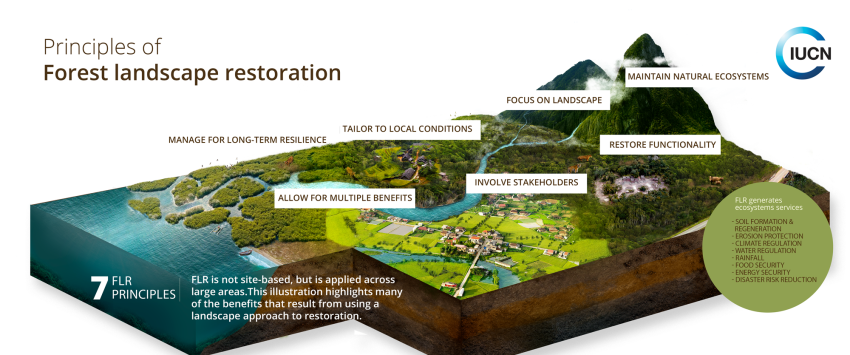Assessing landscape restoration opportunities at the landscape level
Global analysis has found more than two billion hectares of land that could benefit from restoration. What do these opportunities look like at the landscape level? Where should countries, organisations, and individuals interested in restoration begin?
ROAM Handbooks and Videos
 The Guide to ROAM handbook has been developed to guide assessment teams through the ROAM framework – or any subsection of it. This ‘road-test’ version is intended to engage a wide range of disciplines in the process of learning, thereby continuing to improve the methodology. It includes descriptions of the individual tools and components of ROAM as well as guidance on how they can be combined and sequenced to suit different needs. The handbook is available in English, French, Indonesian, Spanish, Portuguese and Russian.
The Guide to ROAM handbook has been developed to guide assessment teams through the ROAM framework – or any subsection of it. This ‘road-test’ version is intended to engage a wide range of disciplines in the process of learning, thereby continuing to improve the methodology. It includes descriptions of the individual tools and components of ROAM as well as guidance on how they can be combined and sequenced to suit different needs. The handbook is available in English, French, Indonesian, Spanish, Portuguese and Russian.
Learn more about ROAM with our series of four animated videos detailing the steps to undertake during a ROAM assessment. The four videos include: ROAM Overview, Phase 1 - Preparation and Planning, Phase 2 - Data Collection and Analysis, and Phase 3 - Results to Recommendations. Watch now in Burmese, English, French, Indonesian, Spanish, Portuguese and Russian.
ROAM can provide vital support to countries seeking to accelerate or implement restoration programmes and landscape-level strategies. In this regard, ROAM will also enable countries to define and implement national or subnational contributions to the Bonn Challenge and concurrently allow nations to meet existing international commitments under the Convention on Biological Diversity, United Nations Convention to Combat Desertification and the United Nations Framework to Combat Climate Change.
A ROAM assessment can be undertaken by a small team through collaborative engagement with stakeholders, and can deliver the following products:
- Identified priority areas for restoration;
- A shortlist of the most relevant and feasible restoration intervention types across the assessment area;
- Quantified costs and benefits of each intervention type;
- Estimated values of additional carbon sequestered by these intervention types;
- Analysis of the finance and investment options for restoration in the assessment area; and
- A diagnostic of ‘restoration readiness’ and strategies for addressing major policy and institutional bottlenecks.
By implementing ROAM, decision-makers and stakeholders can expect to deliver the following types of outcomes:
- Better information for improved land-use decision-making;
- High-level political support for forest landscape restoration;
- Fundamental inputs to national strategies on FLR, REDD+, climate and disaster risk adaptation and mitigation, and biodiversity conservation and restoration, among others, for a mutually reinforcing convergence between such strategies;
- A basis for better allocation of resources within restoration programmes;
- Engagement of and collaboration among key policy-makers and decision makers from different sectors, as well as other stakeholders with interests in how landscapes are managed; and
- Shared understanding of FLR opportunities and the value of multifunctional landscapes.
 Photo: IUCN
Photo: IUCN


